Comet Observations for the Astronomical League Silver
Award
|
Home > AL
Silver Award
|
AL is is
encouraging comet observations and giving a beautiful certificate + pin to
anyone who observes and documents 12 of his comet observations. As I have just
finished observing atleast 12 comets and fortunately sketched them (11 with our
amateur equipments and the 12th one proudly with a professional Observatory
telescope) I have applied for this award. Their rules allow observations through
Observatory telescopes or even Robotic telescopes.
http://www.astroleague.org/al/obsclubs/comet/comet.htm
I became a registered member of the AL as a
"member-at-large". Dr. Eric Flescher, the Chair Person, was very
enthusiastic and cooperative with me in getting this award; my sincere thanks to
him. And the most exciting part is, this is the First International award; until now there has not been
anyone to get this from anywhere outside USA!!! I will upload a picture of the
pin and certificate soon.
The observations, sketches and details are below. Click on the Comet's Sketch to enlarge it.
List of Comets Observed and Sketched for Silver Award:
1. C/2002 T7 (LINEAR)
2. C/2001 Q4 (NEAT)
3. C/2004 Q2 (Machholz)
4. C/2006 A1 (Pojmanski)
5. 73/P Schwassmann-Wachmann 3
6. 4/P Faye
7. C/2006 L1 (Garradd)
8. C/2006 M4 (SWAN)
9. P/2006 T1 (Levy)
10. C/2006 P1 (McNaught)
11. C/2007 E2 (Lovejoy)
12. C/2006 VZ13 (LINEAR)
| |
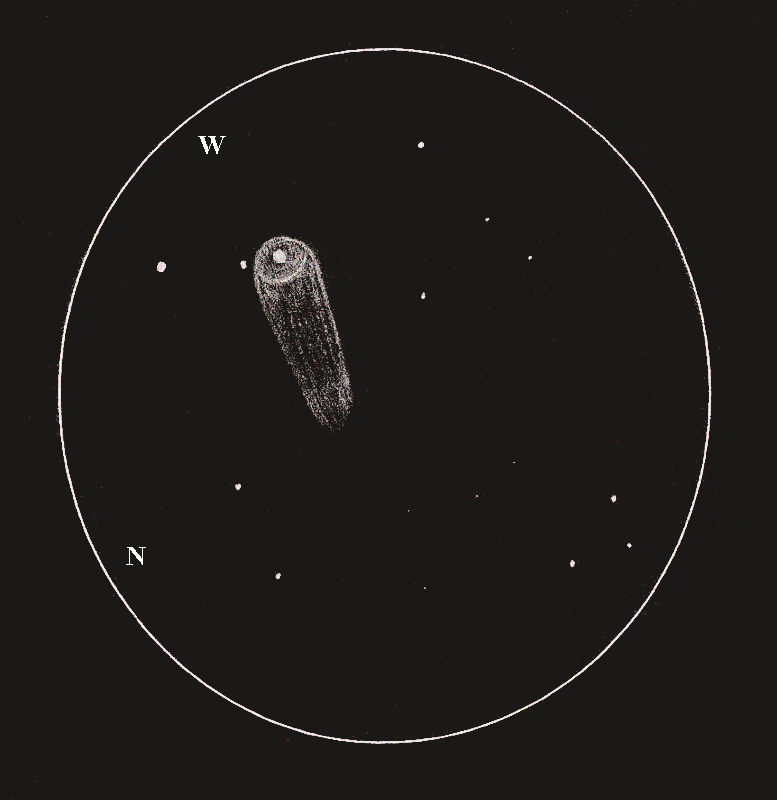 |
1. C/2002 T7 (LINEAR)
Date/Time : 17 January 2004 @ ~3:30 UT
Observing Location : Sivanhalli, 30 km South of Bangalore
Instrument : 8" f/8 Equatorial telescope. 32mm Ramsden eyepiece. A
7x50 binocular mounted on tripod was also used.
Magnification : 48x
FOV : 1 degree
Magnitude : 8
Constellation : Pisces
Sky condition : Sky was dark in that region and transparency and
seeing was good. The comet was in the Western sky not very low.
Transparency and seeing were good. |
|
Description :
It was pretty difficult to find because this was my first comet
observation. And moreover finding an 8th mag comet with 7x50 binoculars
myself then being a beginner, was a true challenge! When I got it with
the 8" telescope it was evident and clearly there, bright and elongated.
The impression to me of the elongated tail coming out from the coma was
like that of "loose hair flowing out of a lady's head". |
| |
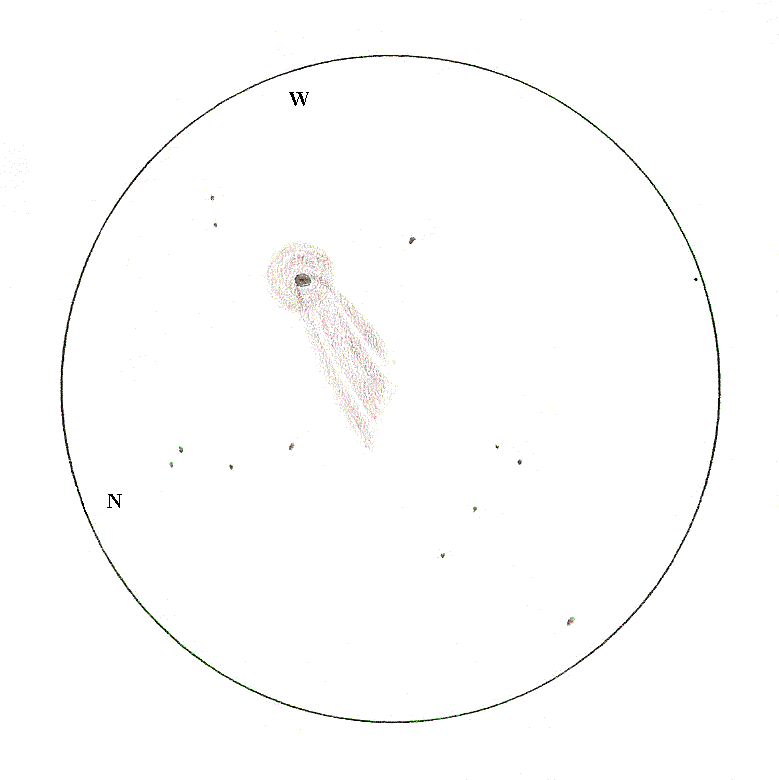 |
2. C/2001 Q4 (NEAT)
Date/Time : 8 May 2004 @ ~ 14:30 UT
Observing Location : Bangalore city
Instrument : 6" f/9 telescope. 32 mm Ramsden eyepiece. First
found out with a 7x50 binoculars after twilight.
Magnification : 42x
FOV : 1 degree
Constellation : Canis Minor / Monoceros
Magnitude : ~6
Sky condition : It was still twilight conditions and not fully dark,
started hunting it then. Managed to get it in binocs in semi-dark skies.
Then after that telescope observation was carried on. Sky transparency
was good. |
| Description : Diffuse and somewhat stretched coma.
It had a bright stellar nucleus with a bright coma around it, covering
the entire field of view. The tail wasn't very clear in a telescope. In
binoculars the comet was clearly visible as a fuzzy object in the
evening sky. |
| |
 |
3. C/2004 Q2 (Machholz)
Date/Time : 11 Dec 2004 @ ~ 16:30 UT
Observing Location : Devanhalli, 30 km North of Bangalore
Instrument : 6" f/9 telescope. 32 mm Ramsden eyepiece.
Magnification : 42x
FOV : 1 degree
Constellation : Eridanus
Magnitude : 6.1
Sky condition : Dark and clear. There was local light pollution
around. Transparency and seeing were good. |
| Description : Very bright, stellar
nucleus, perfectly round coma with an outer fainter envelope. Visible
with naked-eye even from city type of skies and appeared as a fuzzy round ball from
a dark site. |
| |
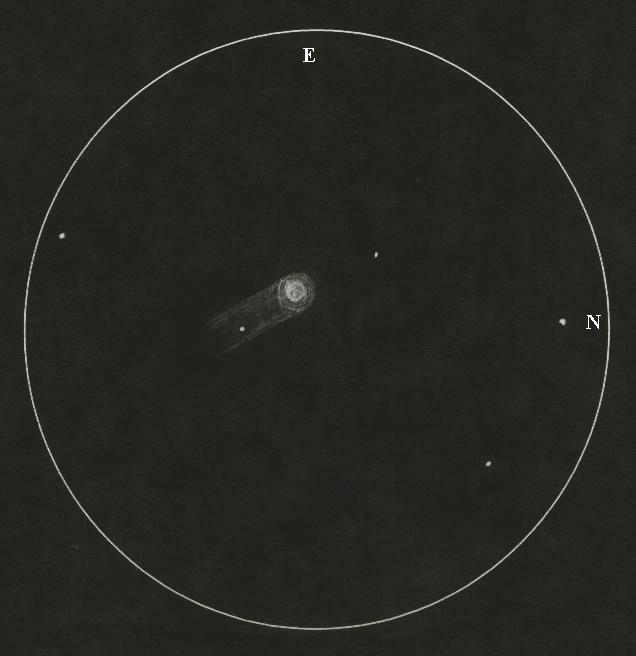 |
4. C/2006 A1 (Pojmanski)
Date/Time : 25 Feb 2006 @ ~ 23:30 UT
Observing Location : Hosahalli, 70 km North of Bangalore
Instrument : 8" f/8 telescope. 32mm Ramsden eyepiece.
Magnification : 50x
FOV : 1 degree
Constellation : Capricornus
Magnitude : ~6
Sky condition : Light polluted in this East direction with reddish
color. The object was some distance above in the horizon. Transparency
and seeing were average. |
| Description : It looked just like a bright
globular cluster in appearance and small in size , highly condensed.
After few seconds of staring a thin extension of haze pointing towards
the west was revealed. This tail was approximately around half degree in
length, very diffuse and thin. |
| |
|
 |
5. 73/P Schwassmann-Wachmann-3
Date/Time : 25 March 2006 @ ~ 17:30 UT
Observing Location : Hosahalli, 70 km North of Bangalore
Instrument : 8" f/8 telescope. 32mm Ramsden eyepiece.
Magnification : 50x
FOV : 1 degree
Constellation : Bootes
Magnitude : ~5
Sky condition : Sky was clear and dark in the direction with slight
light pollution. Transparency and seeing were good. |
|
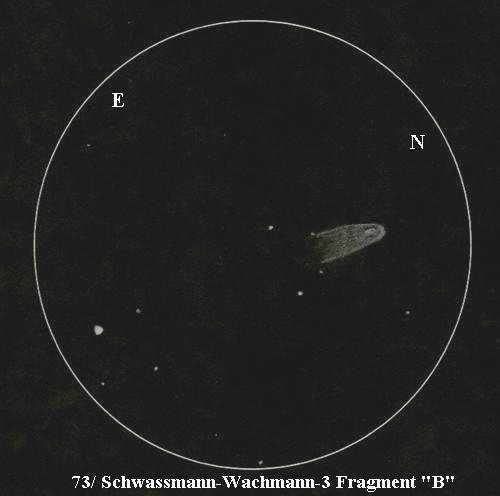 |
Description : "C" & "B" look nearly alike
in both appearance and brightness, but the biggest difference separating
them is their nucleus. "C" had a very bright and distinct nucleus which
was perfectly point-like but very slightly stretched. Whereas B didn't
have any. In "B" there was no difference between the tail and the coma
and both seemed to merge into each other well. However because of the
nucleus of "C" we could differentiate both the coma from the tail. They
were strikingly similar except for the fact that B was much more
diffuse.
The tails were broader at the ends, on the side opposite to the coma
region. In other words, I could see these "fan-tails". |
| |
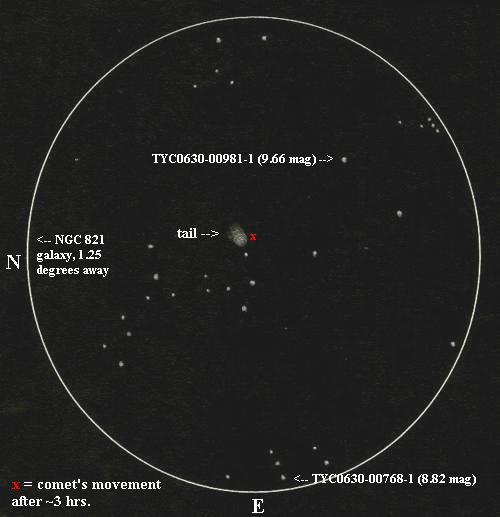 |
6. 4/P Faye
Date/Time : 17 October 2006 @ ~19:30 UT
Observing Location : Hosahalli, 70 km North of Bangalore
Instrument : 10" f/5.1 Dobsonian telescope. 32 mm Ramsden eyepiece.
Magnification : 40x
FOV : 1.25 degree
Constellation : Aries
Magnitude : 9
Sky condition : Sky was dark and good in that direction. Object was
close to zenith. Transparency and seeing were good. |
| Description : This object was a very
beautiful one. It was reminiscent of a small comet painting, with a
small coma and a small tail. The tail was distinct as a protrusion from
the coma. The comet was pretty bright for it's size. This comet, one
of the most beautiful ones I've observed till now, was a
Birthday's Gift to me, when I observed it on 17th October after the
stroke of midnight!! |
| |
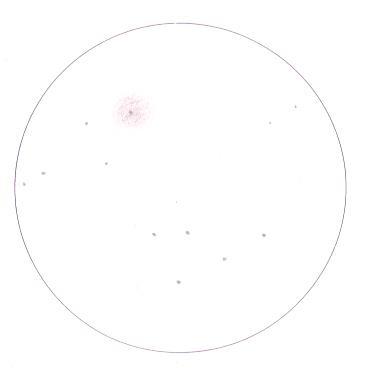 |
7. C/2006 L1 (Garradd)
Date/Time : 21 October 2006 @ ~23:00 UT
Observing Location : Hosahalli, 70 km North of Bangalore
Instrument : 8" f/8 telescope. 32mm Ramsden eyepiece.
Magnification : 50x
FOV : 1 degree
Constellation : Sextans
Magnitude : ~11
Sky condition : Bad background lights. Saw this between terrible
lights from our dark-observing site. |
| Description : With a detailed finder-chart
I finally star-hopped to this location. At first glance there was
obviously just nothing visible then, because of the tremendous
back-ground lights. But further staring slowly started revealing some
very faint thing at my limit of visibility. Hence there was just nothing
that I could observe in the object, except for just 'sensing' it's
presence. There was lots of sky-glow in that region (probably Zodiacal
light?) |
| |
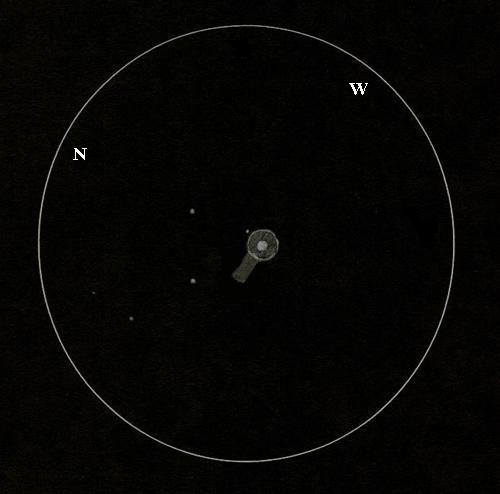 |
8. C/2006 M4 (SWAN)
Date/Time : 26 Oct 2006 @ ~13:30 UT
Observing Location : Hosahalli, 70 km North of Bangalore
Instrument : 8" f/8 telescope. 32mm Ramsden eyepiece.
Magnification : 50x
FOV : 1 degree
Constellation : Corona Borealis
Magnitude : ~6
Sky condition : Object was low in the horizon in west in lots of
light pollution. |
| Description : This was a bright object
through the telescope which I used. It showed a bright coma region as if
radiating light with a brighter stellar condensation. It was reminiscent
of Pojmanski (seen earlier that year). SWAN, with binoculars was as a
fuzzy spot, nearly the same as M13 globular which was at the other edge
of field of view, but slightly brighter and it showed faint extensions
of a very diffuse and thin tail in the direction away from the Sun. I
could also spot this with the naked-eyes as the faintest star seen with
naked-eyes! Yes this was truly spectacular as it had reached just
naked-eye visibility, something not very often. |
| |
 |
9. P/2006 T1 (Levy)
Date/Time : 27 Oct 2006 @ ~23:30 UT
Observing Location : Hosahalli, 70 km North of Bangalore
Instrument : 8" f/8 telescope. 32mm Ramsden eyepiece.
Magnification : 50x
FOV : 1 degree
Constellation : Leo
Magnitude : ~10
Sky condition : Very badly lit up and reddish in color. Mostly it was
the zodiacal light. |
| Description : It was in the eastern
direction, still rising, immersed in zodiacal lights. Making a detailed
finder chart from a software I star-hopped to the location from the star
Phi Leonis for around 4-5 degrees. During this time, it was very close
to the galaxy NGC 3521 in a close rendezvous with it. I could spot the
galaxy first quite easily but had a hard time spotting the comet which
was just nearby. After further staring in the eyepiece and shifting
between eyepieces/magnifications I could spot something very tiny and
non-stellar. This had to be the comet in the predicted position. At this
time it was overlapping an 11th mag. star. and hence the view was a
combined effect. I couldn't observe anything further in this object as
it was at my limit of visibility, very small and immersed in background
lights. |
| |
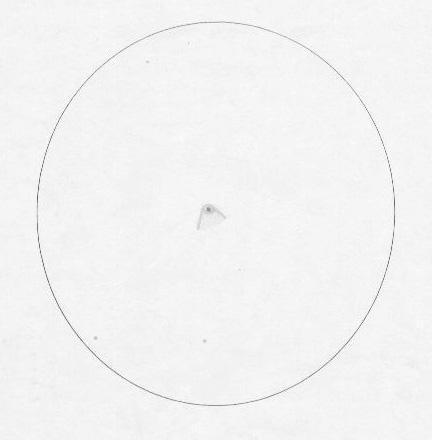 |
10. C/2006 P1 (McNaught)
Date/Time : 14 Jan 2006 @ ~12:30 UT
Observing Location : Yelagiri Hill, 180 km North of Bangalore
in Tamil Nadu State, ~1000 feet high.
Instrument : 12" f/4.5 telescope. 32mm Plossl eyepiece (2-inch
dia).
Magnification : 42x
FOV : ~ 1.5 degree
Constellation : Sagittarius
Magnitude : -6 (!!!!)
Sky condition : It was still bright twilight and Sun had just set.
Sky was bluish and bright in colour. |
| Description : The view of this historic
(and brightest after 41 years) to me through a binocular was that of a
small bright comet in twilight with a clear extension which was the
tail. It resembled like an artist's painting of a small comet! The tail
was broadening out and was small visible. With a 12" telescope in
twilight it showed a stellar bright yellow core with hints of a
parabolic tail, very small. |
| |
 |
11. C/2007 E2 (Lovejoy)
Date/Time : 15 April 2007 @ ~ 21:30 UT
Observing Location : Yelagiri Hill, 180 km North of Bangalore
in Tamil Nadu State, ~1000 feet high.
Instrument : 12" f/4.5 telescope. 32 mm Plossl eyepiece (2-inch
dia).
Magnification : 42x
FOV : ~ 1.5 degree
Constellation : Sagittarius
Magnitude : 8
Sky condition : Dark skies in the east where the comet was.
Transparency and seeing were good. Fog was
very near by this region and was building up soon. Managed to get it
minutes before fog pervaded the region. |
| Description : This comet was very close to
the naked-eye reference star 55 Sagittarius hence very easy to find! It
was pretty bright with relatively high surface brightness. It had a
perfectly circular coma and showed some very slight hints of central
condensation. |
| |
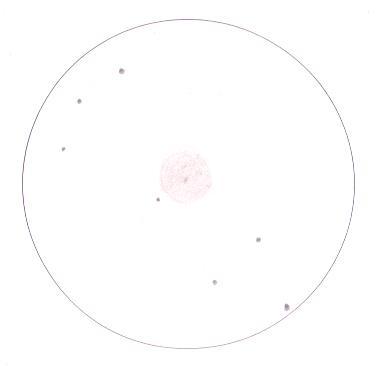 |
12. C/2006 VZ 13 (LINEAR) *
* - With a Professional Telescope and not our
amateur telescopes!
Date/Time : 12 June 2007 @ ~ 22:05 UT
Observing Location : Kavalur Observatory, 180 km from Bangalore
in Tamil Nadu State
Instrument : 1-metre f/13 SCT telescope (!!)
FOV : 10 arc-minutes (0.16 degrees)
Constellation : Andromeda
Magnitude : 10.3
Sky condition : Sky was dark and clear in that direction.
Transparency and seeing were good. |
| Description : I was extremely fortunate to
glimpse this with the 40-inch f/13 SCT telescope at Kavalur
Observatory!! The telescope operator was kind enough to point the
telescope there and spend some time on it. I also got access to the
hand-pad of the Observatory telescope and managed to move the huge telescope around
and hunt for the comet!!! Finally managed to get this very fuzzy and low
surface brightness object in the small field of the eyepiece
(approximately 10-arcinutes!). It has a slight brightening in the
center. Due to the huge magnification and low f.o.v of the telescope, it
was initially quite pretty much difficult getting this comet! |
This is the summary of the 12 comets I've recorded till now. The
details are taken from my Comet Page.
|